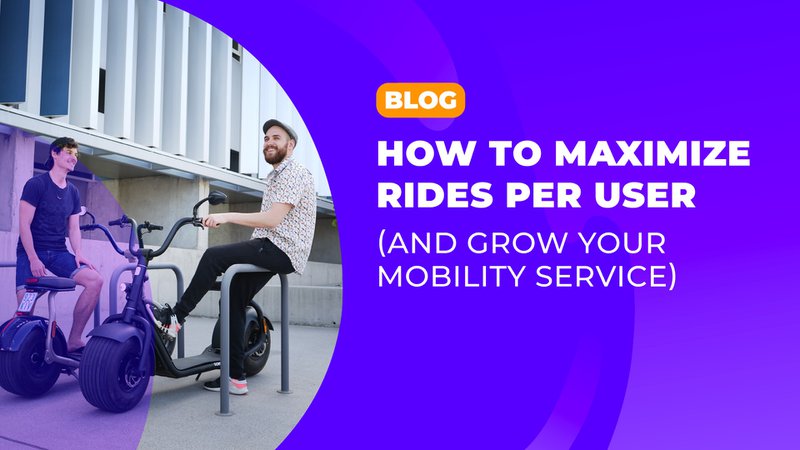How to maximize rides per user (and grow your mobility service)

Customer acquisition is simply too expensive. If mobility operators want to create growth and profitability, they need to focus on their existing customers! That means finding a way to maximize rides per user. Gamification can help! Gamification makes your customer experience more fun, among many other benefits. Today, let’s focus on how gamification can incentivize your customers to take more rides.
- 3 strategies that fuel customer loyalty and engagement
- Why customer experience should be your top priority
- How technology can help mobility improve operational efficiency & the customer experience
- What insights your data can deliver on consumer behavior
- How StriveCloud helps mobility operators maximize rides per user with gamification
- FAQs
3 strategies that fuel customer loyalty and engagement
Loyalty programs
A loyalty program is essential to boost customer loyalty and maximize rides per user. That’s especially true in times of economic uncertainty like 2023. For example, during the 2007 downturn, loyalty program participation grew 19% in just 2 years. It’s not just that people look for discounts in tough times – they also want someone to take care of their needs. And doing so will earn you their loyalty!
These days, consumers expect your loyalty program to be fun as well. No more is this the case than among young people, an important audience for mobility operators. In a study on loyalty programs, Deloitte found that 18-24 year olds consistently preferred loyalty programs with game elements.

Rewards schemes and discounts
For new mobility operators and city launches, hard rewards like discounts are useful to attract new customers. But there are potential drawbacks. A 2021 study found that discounts are most powerful in the first 130 days after product launch. After that, you’ll create what is called the overjustification effect and actually demotivate customers!
Gamification
Gamification is the use of game-like elements such as challenges, levels, and leaderboards and rewarding customers for their achievements with virtual currency badges or free-riding minutes to make their experience more fun and engaging. These gamification features trigger what’s called intrinsic motivation. This is when customers use your mobility service simply because they enjoy it that much! For example, here are 3 gamification features you could introduce in your mobility app to incentivize rides booked by repeat customers:
- Badges & virtual currency. Rewarding customers with virtual currency and badges give them instant feedback on what behaviors are encouraged on your app. What’s more, points are perfect for shared mobility as they can be exchanged for free riding minutes or items in your shop!
- Leaderboards. Ranking customers inspires competition and creates a highly motivating social experience.
- Challenges. Setting a clear goal can trigger customers to take action. For instance, to cover more distance. You can even link it to other game mechanics such as rewarding customers for their achievements with badges or virtual currency, or make them compete against each other in a public in-app leaderboard!
On average, apps see an impressive 22% rise in brand loyalty after introducing gamification! And of course, this helps you maximize rides per user!
Why customer experience should be your top priority
To many consumers today, the only difference between mobility operators is the color of your vehicle! So if you really want to stand out, you need a great customer experience. Research by McKinsey supports this. They found that consumers named availability and reliability as 2 of the most important things that mobility apps should offer.

In other words, a working vehicle where and when the customer wants it. Of course, putting a vehicle on every corner is not a solution to maximize rides per user. That’s neither possible nor profitable! Instead, what you need to do is leverage the right technology to achieve your operational & growth goals!
How technology can help mobility improve operational efficiency & the customer experience
Your goal as a mobility operator is to offer a seamless, efficient, and personalized service. For that, you need the right tools:
Chatbots and customer service
Customer service costs around 10-15% of your revenue. However, a good chatbot reduces those costs without sacrificing the quality of your customer service. Given that consumers today expect a response in 10 minutes or less, it’s no wonder that 70% of consumers now prefer chatbots for fast support. Remember, the faster the support, the faster the customer can get back on your vehicle!
And because competition is so strong in mobility, your customer service is extra crucial. Today, 33% of people would leave a brand after just one bad experience!
Fleet rebalancing
You must have accurate and up-to-date data for your fleet. Knowing where your vehicles are, where they need to be, and which need charging, is important for multiple reasons:
- Customers are more likely to find a vehicle when they need it, which helps to maximize rides per user
- Increased profitability, as supply is matched to demand – when your fleet is elsewhere, you lose money
- Rebalancing is often required by city regulators to avoid improperly parked vehicles
Partnerships & integrated apps
Partnerships can be mutually beneficial. Especially when the end-user wants to combine multiple modes of transportation. For example, e-scooter operator Circ joined Spanish train operator Renfe and taxi app Cabify to create an integrated mobility app that benefits all three companies – but most importantly, the customer!

What insights your data can deliver on consumer behavior
They say that knowledge is power. But when it comes to data, it really is true. Hidden in the data that all mobility apps collect are insights into customer behavior and preferences. In fact, a recent study showed how data can be used to enhance customer satisfaction:
Transport Policy, Volume 100 – “An app, called ‘Metropia,’ incorporated personalized rewards with predicted travel time, and showed that users change both departure time and route for 35% of their trips… this helps mobility apps get positive feedback and gain more customers.”
Now, many mobility operators already use customer data to manage their fleets, but some also use it to optimize pricing strategies.
Improved dynamic pricing
The more you know about your customers, the better your dynamic pricing will be. This means higher fees in peak times and lower fees in quiet periods, which maximizes rides per user and ensures full fleet utilization. But you can’t do that if you don’t know when those times are, and what the limits are that customers will pay!
Personalized pricing strategies that lead to loyalty
Take Lime for instance. Their monthly subscribers pay zero fees to unlock an e-scooter. Even better, some mobility operators offer prices that depend on the distance traveled and trip duration. This feeds into the ‘Lucky Loyalty effect’, which says that the more loyal a customer is, the better they expect to be treated!
How StriveCloud helps mobility operators maximize rides per user with gamification
If you want to maximize rides per user, you need a great app experience. That’s because your app is the center of everything – it’s where customers sign up, pay, and hitch a ride. StriveCloud helps mobility operators create a fun and unique experience by introducing gamification & loyalty features inside the app.
Here are three main ways we achieve that:
- Incentivize behaviors with in-app rewards to maximize rides per user – On average we’ve helped mobility operators double rides per user.
- Build a loyal & engaged customer base – Our customers see an average increase of 300% in trips booked by active customers.
- Create an engaging experience around your mobility service – Empower your brand narratives with fun gamification features such as challenges, levels & achievements!
Our software makes it easy for you to add all types of features from points & badge reward systems to daily quizzes, lotteries, in-app currencies, leaderboards, and more! We have over 20 powerful interactive features you can use to engage your customers.
Michael Stewart @HumanForest – “What’s unique about StriveCloud compared to a regular loyalty program or customer marketing is that your customer’s experience is inside the app, at the moment they are using it.”
So why does it work? Well, first of all, the shared mobility model is well-suited for gamification. That’s because reward systems are in line with business goals and such as maximizing rides per user. Additionally, the target audience for mobility responds very well to gamification.
Furthermore, our experience and expertise in the area of gamification allows us to easily create a winning strategy! By combining extrinsic motivation, (from things like rewards and discounts), with intrinsic motivation, (leveraging progress, achievement, and empowerment), we manage to fuel long-term engagement and loyalty. In fact, our clients see an average 300% increase in trips completed by active customers!

